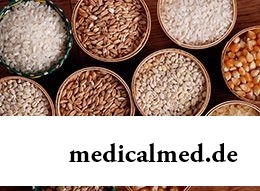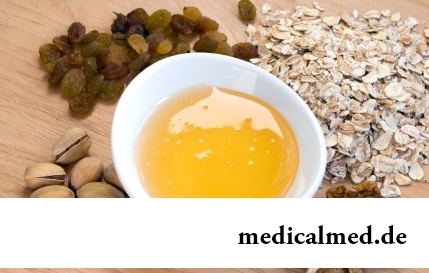





Caloric content of grain
 Grain is a valuable foodstuff which is a source of complex carbohydrates, vitamins and microelements. Caloric content of grain in a dry form makes from 300 to 350 kilocalories on 100 grams. Such high energy value made grain irreplaceable during all centuries of history of mankind. Today more and more people aim to reduce menu caloric content to lose weight. But whether it is necessary to refuse grain? How to keep this valuable product in a diet and not to recover? Whether it is possible to lose weight by means of a cereal diet? In this article we will discuss all these questions.
Grain is a valuable foodstuff which is a source of complex carbohydrates, vitamins and microelements. Caloric content of grain in a dry form makes from 300 to 350 kilocalories on 100 grams. Such high energy value made grain irreplaceable during all centuries of history of mankind. Today more and more people aim to reduce menu caloric content to lose weight. But whether it is necessary to refuse grain? How to keep this valuable product in a diet and not to recover? Whether it is possible to lose weight by means of a cereal diet? In this article we will discuss all these questions.
Calories in grain
Grain represents whole or shredded grains of various cultures. Cereals and bean grain plants are most widely used in agriculture. A source of calories in grain are complex carbohydrates. These substances are considered as a basis of healthy food. Due to their energy more than on a half energy value of a daily diet has to form. If the person refuses complex carbohydrates, then in his metabolism there are adverse changes. Any low-carbohydrate deprivation diets lead to decrease in body weight, but after their termination weight quickly is returned. Caloric content of grain is not so high that the growing thin person needed to refuse them completely. Besides, calories in grain are acquired with a low speed. Friable whole grain in a boiled look will be digested most slowly. It is necessary to use products from grain in moderate quantities.
Caloric content of grain in a dry form
On packaging of a product the caloric content of grain in a dry form is specified. In calorie charts of foodstuff usually energy value of grain in a dry form is written too. Let's consider the caloric content of grain of some specific grades. Most often in Russia eat buckwheat cereal. For its preparation buckwheat unground buckwheat is used or (308 kilocalories in 100 grams), or buckwheat passed (300 kilocalories in 100 grams). Grits caloric content – 342 kilocalories. Energy value of the Oat-flakes oat flakes is even higher – 352 kilocalories in 100 grams. Rees in a dry form contains 303 kilocalories on 100 grams. Pearl barley – 320 kilocalories. Higher semolina caloric content – 333 kilocalories in 100 grams. Split peas have a little smaller caloric content – 299 kilocalories. It is convenient to use the caloric content of grain in a dry form when you prepare a dish. If you eat food already ready (for example, in cafe or if it is cooked by relatives), it is better for you to use information on grain caloric content in a boiled look.
Caloric content of grain in a boiled look
In a boiled look caloric content of grain not really big. While grain cooks, it absorbs a large amount of water (3 times more than a body weight). Water does not contain calories therefore energy value of ready grain is lower, than dry. In 100 grams of the welded grain about 100 kilocalories. Semolina porridge on water contains in 100 grams 80 kilocalories. Porridge – 88 kilocalories. Buckwheat caloric content in a boiled look – about 95 kilocalories in 100 grams. Caloric content of cereal products, including porridges, depends on a way of their preparation. If you cook porridge on milk, add oil, honey or sugar, then energy value of such product will be much higher, than at the simple grain welded on water. To minimize the caloric content of grain and dishes from them, do not add any fats during culinary processing. It is possible to add fresh fruit or low-calorie sweeteners to already ready porridge. Of course, such recipe can seem to you at first not too attractive. However, porridge with fruit is not only dietary product, it both really tasty and useful breakfast or a dinner.
Caloric content of cereal flakes
 Those who watches over the health and weight know well a modern dish for breakfasts – muesli. If you keep a figure, then consider that muesli can be very caloric. At their structure often there are cereals, bran, dried fruits, nuts, spices, honey. Caloric content of cereals not completely defines energy value of this food, but plays in it not the last role. In 100 grams of instant cereal flakes more than 320 kilocalories. Caloric content of cereal flakes depends on their chemical composition. The more fat in flakes, the higher them energy value. Oat flakes (about 7,5% of weight) contain the greatest number of fat. Nuts, honey, many dried fruits contain many calories (more than 400 kilocalories in 100 grams). If you add fat milk, cream to muesli, then thereby you increase dish caloric content even more. Caloric content of cereal flakes with spices and the fat-free yogurt will be minimum in comparison with other types of muesli.
Those who watches over the health and weight know well a modern dish for breakfasts – muesli. If you keep a figure, then consider that muesli can be very caloric. At their structure often there are cereals, bran, dried fruits, nuts, spices, honey. Caloric content of cereals not completely defines energy value of this food, but plays in it not the last role. In 100 grams of instant cereal flakes more than 320 kilocalories. Caloric content of cereal flakes depends on their chemical composition. The more fat in flakes, the higher them energy value. Oat flakes (about 7,5% of weight) contain the greatest number of fat. Nuts, honey, many dried fruits contain many calories (more than 400 kilocalories in 100 grams). If you add fat milk, cream to muesli, then thereby you increase dish caloric content even more. Caloric content of cereal flakes with spices and the fat-free yogurt will be minimum in comparison with other types of muesli.
Cereal diet
Caloric content of grain without additives rather low. They contain the mass of useful substances and well satisfy hunger. On the basis of grain the special cereal diet for decrease in body weight is created. It is a restrictive power supply system which can be recommended for disposal of excess weight to the people who do not have the expressed problems with health. This diet is transferred well. But, as well as any power supply system with sharply limited set of products in the menu, this diet is unbalanced. You should not adhere to it more than 7 days. Big plus of a cereal diet can be considered its profitability. The essence of this power supply system consists in what is it is possible only porridges and to drink water in a large number. Grain should be cooked without salt, sugar, milk and oil. Such porridge will be pleasant not to all to taste, but in it there are not enough calories and there is almost no fat. Millet, buckwheat, wild rice, oats, red lentil will be suitable for a cereal diet. You should not use white rice, semolina and any instant flakes. All days of a diet for breakfast, a lunch, a dinner eat 150 or 200 grams of any porridge. Still during the day it is possible to use 300 grams of vegetables (except potatoes) and 250 grams of the fermented milk fat-free product. Have green or herbal tea without restrictions. It is also possible to use clear drinking water.
For example, for breakfast eat buckwheat cereal, for lunch – porridge and fresh tomatoes salad with a spoon of yogurt and spices, for dinner – porridge from lentil and a glass of yogurt. Within 7 days of a cereal diet you will lose from 2 to 4 kilograms of excess weight. To increase efficiency of a diet and to improve health, add half an hour of physical exercises to a daily daily routine.
Grain did not lose the value in food of the modern person. Carbohydrates, vitamins, microelements in their structure are useful to a metabolism and health in general. Caloric content of grain is rather high to support forces during the day. At the correct use of grain not only do not harm a figure, and on the contrary, help to lose weight. The cereal diet – the most economic and easy way to lose weight without harm for health for a small period.
Except people, only one living being on the planet Earth – dogs suffers from prostatitis. Here really our most loyal friends.

The endocrine system carries out in a human body extremely important role, practically all processes of life activity регулируютс...
Section: Articles about health
Scientists have no unambiguous opinion on a proximate cause of emergence of a carcinoma cutaneum today. Only the factors promoting development of this illness are precisely established. Treat them: long impact on skin of ultraviolet rays, radioactive...
Section: Articles about health
The brain of the person is studied not one hundred years, but the quantity of the riddles connected with this body increases rather, than decreases. Perhaps, numerous delusions concerning a structure and functioning of a brain are explained by it, many of which arose long ago, but continue to exist and today. Such we are ready to acquaint readers with the most widespread myths....
Section: Articles about health
Let's begin with the fact that a separate illness which is called "adjournment of salts", just does not exist. In practice this household name of plank beds...
Section: Articles about health
For anybody not a secret that our country is one of the most "drinking" in the world. At clear understanding that the use of hard alcoholic drinks – occupation extremely harmful, most of Russians belong to alcoholism with unjustified loyalty. These...
Section: Articles about health
Many parents of children at the age of 2-4 years face excessively whimsical behavior of the child. The kid exhausts constant crying and whims not only the parents, but also himself. In what the reasons of children's whims. And how to fight with them?...
Section: Slideshow
Life of the modern child is extremely active and difficult. Information strain which is experienced by the school student and did not dream the pupil...
Section: Articles about health
Modern footwear is extremely various. It stopped being only protection for legs long ago. Today shoes, boots, barefoot persons choose not so much proceeding from their convenience and functionality how many being guided by outward, brand and an opportunity to add with it...
Section: Articles about health
The state of health of the person depends on many factors. One of the most important is the constant, but not exhausting a physical activity. In the presence of various illnesses specialists often advise patients to do swimming which by right takes the leading place by efficiency of improvement, having at the same time a few contraindications. Today we will talk about the main directions of therapeutic impact of swimming on a human body....
Section: Articles about health
The Genetically Modified Organisms (GMO) are plants or animals (as a rule, agricultural) in whose genotype...
Section: Articles about health
Hemorrhoids – extremely widespread disease. Periodically arising inflammations and bleeding of hemorrhoidal nodes cause serious discomfort to nearly fifteen percent of adults. Meanwhile, having a clear idea of the aggravation reasons...
Section: Articles about health
It is difficult to revaluate importance of kidneys for an organism. These bodies not only perform work on purification of blood of decomposition products and removal of excess liquid. They are responsible also for production of some hormones necessary for maintenance of a normality of a bone tissue, and also for a producing red blood cells – erythrocytes....
Section: Articles about health
Antibiotics - - it is possible to call the chemical compounds suppressing growth of bacteria the break in the field of medicine which allowed to save persons...
Section: Articles about health
Memory is an ability of the central nervous system to fix, keep and as necessary to reproduce information on knowledge or skills received by the person or an animal during life. The mechanism of this process is up to the end not studied....
Section: Articles about health
Women quite often suffer from complexes concerning the sizes of the bust. Strangely enough, not too modest, and excessively curvy shapes become the reason of sincere discomfort sometimes. Except psychological problems, the big bust sometimes creates also quite notable malfunctions with health: his owner can feel muscular dorsodynias, feeling of constant fatigue and difficulty of breath. Over time excess loading leads to development of diseases позвоночн...
Section: Articles about health
Practice of use of table salt in the therapeutic purposes contains not one century. Appl are considered especially effective...
Section: Articles about health
Herpes simplex of the first type (the infectious disease which is shown periodic bubble rashes on lips is called) – one of the most widespread illnesses. Statistically, only 5% of inhabitants of our planet are unreceptive to its activator, and...
Section: Articles about health
For the city dweller the fitness is the most convenient sport. It is enough to acquire the subscription to the gym to get access to various apparatuses and an opportunity to train under the leadership of the experienced consultant. Many consider fitness the best way of maintenance of physical shape and receiving dynamic loads which the people occupied preferential with brainwork so need. Nevertheless, representations of most of consumers of similar services about специф...
Section: Articles about health
Work of a brain is extremely complex and in many respects is not studied yet. It is confirmed also by the features of thought processes which are shown in...
Section: Articles about health
The depression not without reason is considered one their main troubles of our century: for scientific and technical progress, acceleration of rate of life and a surplus of information of people it is forced to pay with stresses, negative emotions and weakening of protective forces of an organism. As a result ш...
Section: Articles about health
The medicine promptly develops, and the fact that else quite recently it seemed by miracle can now. We are not surprised any more to the fact that people with artificial joints and extremities can play sports, organ transplantation became a routine, and the latest cancer medicine allowed to achieve reduction of mortality in tens of times. Miracles of plastic surgery thanks to which people in 60 years are in the flower of beauty and freshness, too not a sensation any more....
Section: Articles about health
Each of us faces from time to time that other people need the immediate help. We react to it on-raznomu:...
Section: Articles about health
A lot of things depend on a condition of a backbone in a human body, a backbone - not only a support for a body, it also a receptacle for a spinal cord, that is why malfunctions with a backbone are so dangerous. To treat rachis diseases very difficult and long...
Section: Articles about health
Practically each person is familiar with the annoying, pulling, unscrewing pains caused by overcooling of muscles of a back. In certain cases inflammatory process is not limited to discomfort, being followed by emergence of hypostasis, consolidations, temperature increase. At the wrong treatment the acute miositis can lead to a chronic disease or aggravation of other pathologies of a back (vertebral hernia, osteochondrosis) therefore it is important to pay attention to symptoms of an illness in time and to start to...
Section: Articles about health
For the person who daily since morning gathers for work it is very important to wake up vigorous and ready by day of work. On most...
Section: Articles about health
The phenomenon of improvement of a condition of the patients at administration of drugs who are not containing active agents, so-called effect of placebo is known long ago. At the end of the 18th century the American doctor Perkins began to treat people the "miracle" sticks made of a spl...
Section: Articles about health
Deciding to get rid of an addiction, not all imagine what effects it is necessary to face. Process of refusal of smoking causes quite essential discomfort in most of people: differences of mood, a sleep disorder, fatigue, decrease in physical and intellectual activity and a number of other symptoms reducing quality of life. Abstinence can be strong: an essential part of attempts comes to an end leaving off smoking failure, and people are returned to the use of cigars...
Section: Articles about health
